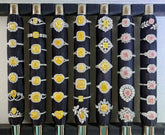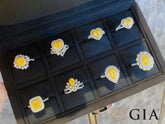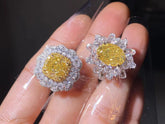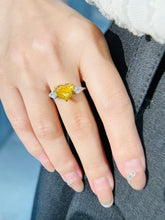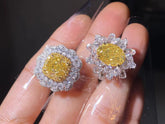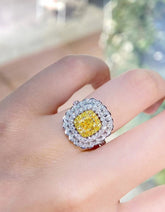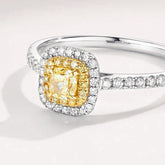Five reasons to choose laboratory-grown diamonds.
With the shift of major watch and jewelry brands like Pandora and Breitling, you've undoubtedly heard of laboratory-grown diamonds. But do you know what they really are? Should you buy them?
They have the same chemical composition as natural diamonds and require special techniques to distinguish them. As the name suggests, diamonds are made in the laboratory by exposing carbon to high pressure and high temperature, mimicking the conditions under which natural diamonds were formed millions of years ago underground.
With an increasing number of jewelry brands offering lab-grown diamond jewelry — Courbet, Vever, Vrai, Or & Elle, Kimaï, Oscar Massin — most jewelers sell these diamonds alongside natural diamonds, such as Chupi's One in a Trillion series. Here are five reasons to consider buying them.
1: No mining required
Mining natural diamonds is complicated. According to the lab-grown diamond brand 'Clean Origin,' for every 1-carat diamond mined, 100 square feet of land needs to be excavated, producing 6,000 pounds of mineral waste, leading to habitat destruction. Lab-grown diamonds do not require mining. Some companies suggest that this means lab-grown diamonds are more sustainable than natural diamonds. This is controversial, but it's important to note that not all producers of these stones are the same, and producing them requires a significant amount of energy to reach the high temperatures and pressures. If sustainability is your main driver, be sure to look for certified carbon-neutral producers, such as Diamond Foundry.
For top sustainability certification for diamonds, look for those with the SCS 007 certificate, such as Latitude, GreenRocks, and LUXX (invested by LVMH). Ask your jeweler about the source of your lab-grown gem, just as you would with a natural gem.

If sustainability is your primary driver, be sure to look for certified carbon-neutral producers, such as Diamond Foundry.
2: No chance of getting blood diamonds
While conflict diamonds currently make up only 1% of the global supply, the proportion was much higher in the past. According to the Kimberly Process, established to prevent blood diamonds, this proportion was as high as 15% in the 1990s. There are also issues of colonialism, true ownership, and equitable wealth distribution to consider: despite possessing some of the world's most valuable natural resources, diamond-producing countries or regions often remain impoverished. Antique or vintage diamonds are often considered a more ethical choice, but this depends on how far back your memory stretches. Many natural diamonds are recycled and recut, and the older the stone, the less likely human rights concerns were considered during mining. This is not a concern with lab-grown stones.

OR & ELLE is a family jewelry brand based in Antwerp, Belgium, which exclusively uses 100% traceable, climate-neutral lab-grown diamonds and recycled gold. Each piece of jewelry is bespoke, handcrafted, and set by experienced skilled craftsmen.
3: Spend less for more luxury items
One of the biggest attractions of lab-grown diamonds is their price. You can buy a virtually identical stone for a fraction of the cost, visible to the naked eye — even trained eyes. This is especially true for colored diamonds, as naturally occurring blue, pink, and yellow diamonds are exceptionally expensive, whereas these colors can now be created in a lab. The difference in cost you'll pay for mining and manufacturing is significant.
To better understand the cost savings, we compared two identical engagement rings: a delicate 18-carat white gold solitaire ring, set with a 1-carat D-color SI2 diamond cut from 77 stones. The natural diamond ring priced at under £4,340, while the lab-grown diamond ring was approximately £1,190. This represents a saving of over 70%, which feels appropriate considering the current wholesale price difference between the two gemstones. However, not all retailers pass these savings on to consumers. If your jeweler offers only a 30% discount from natural prices, you may be overpaying. This downward pricing trajectory is likely to continue in the coming years, but if you're not concerned about investment and simply want an affordable, beautiful gemstone, lab-grown is the way to go.

77 Diamonds offers meticulously crafted jewelry for jewelry enthusiasts, available for purchase on a user-friendly website that allows for customizing rings and selecting from natural diamonds, lab-grown diamonds, and other gemstones. The natural diamond ring mentioned above is priced at under £4,340, while the lab-grown diamond ring is approximately £1,190.
4: Quirky science fun
For decades, we've been drawn to the romance of diamonds: they formed millions or billions of years ago deep in the Earth's crust, just waiting to find their way to you. It's a beautiful story, but for anyone interested in science and technology, the creation story of lab-grown diamonds also has its own romantic appeal. Humans can recreate diamonds in the lab through a series of cutting-edge techniques, and there's plenty of fun to be had in that. It's also a great story to share with any admirers of your lab-grown diamonds.

Responsible practice is at the core of Chupi's philosophy, as founder Chupi Sweetman explains: 'This is a pivotal moment for us as we launch our most sustainable collection to date. Lab-grown gems are the future of diamonds. As a brand, our next decade will be epitomized by this collection.'
5:New possibilities
As laboratory-grown diamonds are cultivated to specifications in a controlled environment, they open up many design possibilities that natural diamonds cannot achieve; or if they can, they often come at a prohibitive cost. TAG Heuer has crafted some experimental watches using laboratory-grown diamonds, including the Carrera Plasma Diamant D'avant-garde. Custom-cut irregular-shaped laboratory-grown diamonds are set into the case and bracelet, with the most striking feature being the watch's face carved from a single laboratory-grown diamond.
Other experimental applications include jewelry brand Vrai creating a cross made from a laboratory-grown diamond, and former Apple Chief Design Officer Jony Ive and industrial designer Marc Newson designing an entire solid laboratory-grown diamond ring for The Diamond Foundry.

Founded in Los Angeles in 2014, VRAI has grown rapidly as the direct-to-consumer (D2C) arm of Diamond Foundry on a global scale. The company operates a zero-emission casting facility in Wenatchee, Washington, leveraging hydropower from the Columbia River. Since 2017, VRAI has been certified carbon-neutral by Climate Impact Partners.

TAG Heuer has created some experimental watches using laboratory-grown diamonds, including the Carrera Plasma Diamant D’avant-garde.

The Ginkgo ring by Vever is crafted from recycled gold and adorned with three laboratory-grown diamonds, a testament to the brand's creativity and impeccable goldsmithing techniques.

Blue diamonds are extremely rare in nature and difficult to cultivate in the laboratory, so in this necklace by Courbet, it's a testament to their technical prowess to harvest so many perfectly matched lab-grown blue diamonds.

Courbet's Celeste necklace is dedicated to innovation, crafted from recycled platinum and laboratory-grown diamonds, offering a sustainable choice for jewelry enthusiasts concerned about diamond sourcing.

The Dublin jewelry brand Chupi celebrates a decade of timeless jewelry. This impressive engagement ring comes from their latest One In A Trillion series, marking the brand's first use of laboratory-grown diamonds in its history.

Oscar Massin, a forgotten renowned Belgian jeweler, worked in Place Vendôme in the 19th century. In 2022, investors revived the brand, launching new jewelry featuring climate-neutral lab-grown Latitude diamonds produced by WD Diamonds in Washington, D.C
———— / END / ————
